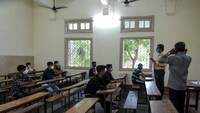
Kevin.Mendonsa
Mangaluru: It would follow that the indefinite closure of educational institutions, particularly those of higher learning, owing to the Covid-19 crisis would have paralysed the market for narcotic substances in Dakshina Kannada and Udupi districts, but such is not the case. The trade of drugs continues unabated, virtually unaffected by the suspension of most businesses in the coastal districts, which are home to prestigious universities and higher education institutions, wherein nearly five lakh students are estimated to be pursuing various courses.
A senior police official familiar with the functioning and operations of the drug racket said that, the pandemic may have forced those involved in the illegal business to make some changes, but the sale of narcotic substances continued to be going strong. “The seizure of the huge cache of ganja a few weeks ago attests to this. The peddlers have been very active since the lockdown was lifted,” he said. While ganja remains the most popular drug, ecstasy, lysergic acid diethylamide (LSD) and hash oil are the other narcotic substances much in demand in the two coastal districts.
Another cop in Mangaluru said that students pursuing medicine constituted the bulk of the customers for the peddlers, followed closely by engineering students, and those pursuing other professional courses. “Interestingly, a few students also double as peddlers. Once a student gets addicted, he or she may also take to selling the substance on the campus. That way, peddlers reduce their exposure, and the students get to purchase it from someone they know. This is prevalent on many college premises, but remains unnoticed,” he added.
Professionals working in a stressful working environment, those whose working timings are irregular, constitute another section of the customer base for narcotic substances.
A Mangaluru-based counsellor pointed to the rise in the number of high-school students getting addicted to drugs. “Earlier, most students picked up the habit after entering PU, but this is not the case anymore. Owing to addiction, many high-school students are dropping out, while many in the 18 to 30 age group are ending up in rehabilitation centres,” the counsellor said.
Former director general of the National Academy of Customs, Indirect Taxes and Narcotics G Shreekumar Menon, who has studied the rampancy of drug abuse in the coastal districts, said that the nefarious network had spread its tentacles wide and deep into the educational institutions. He opined that students either consumed drugs to feel euphoric or to keep their undivided attention on studies without feeling physically stressed or sleepy.
Mangaluru: It would follow that the indefinite closure of educational institutions, particularly those of higher learning, owing to the Covid-19 crisis would have paralysed the market for narcotic substances in Dakshina Kannada and Udupi districts, but such is not the case. The trade of drugs continues unabated, virtually unaffected by the suspension of most businesses in the coastal districts, which are home to prestigious universities and higher education institutions, wherein nearly five lakh students are estimated to be pursuing various courses.
A senior police official familiar with the functioning and operations of the drug racket said that, the pandemic may have forced those involved in the illegal business to make some changes, but the sale of narcotic substances continued to be going strong. “The seizure of the huge cache of ganja a few weeks ago attests to this. The peddlers have been very active since the lockdown was lifted,” he said. While ganja remains the most popular drug, ecstasy, lysergic acid diethylamide (LSD) and hash oil are the other narcotic substances much in demand in the two coastal districts.
Another cop in Mangaluru said that students pursuing medicine constituted the bulk of the customers for the peddlers, followed closely by engineering students, and those pursuing other professional courses. “Interestingly, a few students also double as peddlers. Once a student gets addicted, he or she may also take to selling the substance on the campus. That way, peddlers reduce their exposure, and the students get to purchase it from someone they know. This is prevalent on many college premises, but remains unnoticed,” he added.
Professionals working in a stressful working environment, those whose working timings are irregular, constitute another section of the customer base for narcotic substances.
A Mangaluru-based counsellor pointed to the rise in the number of high-school students getting addicted to drugs. “Earlier, most students picked up the habit after entering PU, but this is not the case anymore. Owing to addiction, many high-school students are dropping out, while many in the 18 to 30 age group are ending up in rehabilitation centres,” the counsellor said.
Former director general of the National Academy of Customs, Indirect Taxes and Narcotics G Shreekumar Menon, who has studied the rampancy of drug abuse in the coastal districts, said that the nefarious network had spread its tentacles wide and deep into the educational institutions. He opined that students either consumed drugs to feel euphoric or to keep their undivided attention on studies without feeling physically stressed or sleepy.

Coronavirus outbreak
Trending Topics
LATEST VIDEOS
City
 Kangana Ranaut hits back at Shiv Sena, after Maha govt's drug allegation
Kangana Ranaut hits back at Shiv Sena, after Maha govt's drug allegation  Mandatory face mask, no assemblies: Centre's SOPs for partial reopening of schools from September 21
Mandatory face mask, no assemblies: Centre's SOPs for partial reopening of schools from September 21  Sushant Singh Rajput death probe: NCB takes Rhea Chakraborty into custody
Sushant Singh Rajput death probe: NCB takes Rhea Chakraborty into custody  Kannada film drug racket probe: Actor Sanjjanaa Galrani arrested
Kannada film drug racket probe: Actor Sanjjanaa Galrani arrested
More from TOI
Navbharat Times
Featured Today in Travel
Quick Links
Kerala Coronavirus Helpline NumberHaryana Coronavirus Helpline NumberUP Coronavirus Helpline NumberBareilly NewsBhopal NewsCoronavirus in DelhiCoronavirus in HyderabadCoronavirus in IndiaCoronavirus symptomsCoronavirusRajasthan Coronavirus Helpline NumberAditya ThackerayShiv SenaFire in MumbaiAP Coronavirus Helpline NumberArvind KejriwalJammu Kashmir Coronavirus Helpline NumberSrinagar encounter
Get the app



